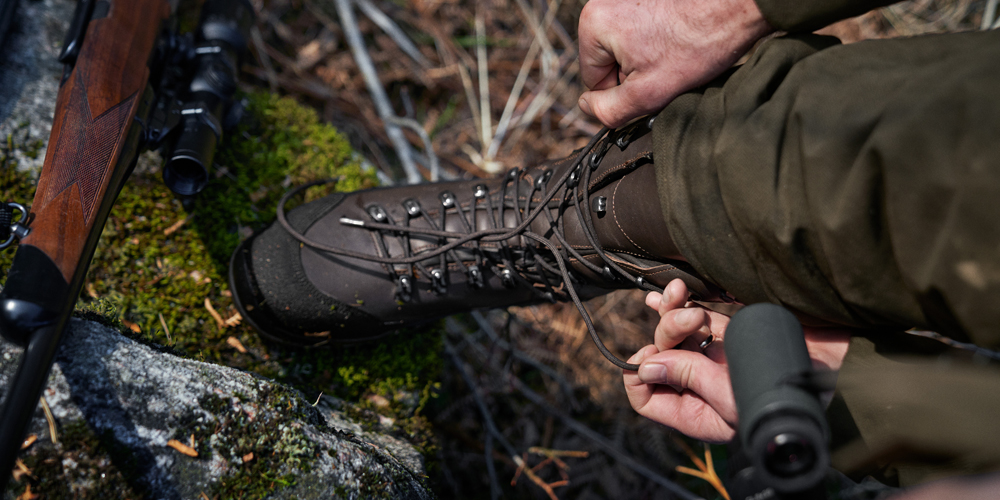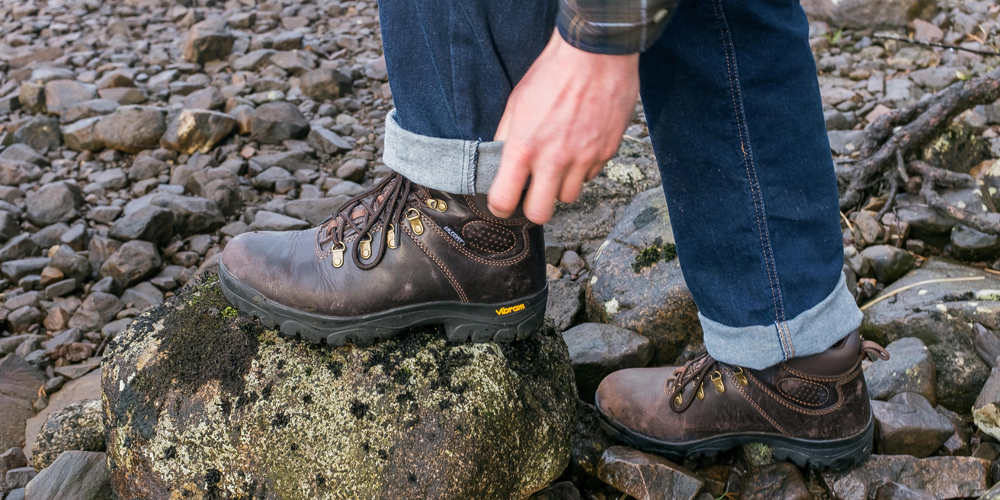Choosing Boots for the Field
Features to look out for when choosing a boot for stalking or beating.
There are three almost universal features that are found in virtually all the leading brands of shooting boots on the market. They generally have a full leather upper, Vibram sole and a Gore-Tex lining. Check out the Meindl Dovre boot as the perfect example of a boot that features all three.
What differentiates a stalking and beating boot from a walking boot?
On the face of it walking and stalking boots share many similarities. They both need to support the foot and ankle, have plenty of grip and most provide waterproof protection. The key difference with a boot designed specifically for shooting – whatever type of shooting that might be, is that is needs to be more durable to withstand the rougher abuse of regularly walking through brambles, heather and gorse. The other big difference is height, there are very few walking boots taller than 8”, whereas stalking boots are commonly

Features to consider when making your choice
Outer Fabric
The outer fabric of the boots needs to be durable, from a wear and tear point of view, there’s no point in a great boot if the outer can’t withstand the abuse and abrasions it receives on a shoot day, and, because the Great British weather is not reliable, you need a boot which can withstand the repetitive cycle getting wet and drying out. Your two main options are traditional leather, or synthetic options. Leather undoubtedly stands the test of time, and works well with a breathable lining, but it needs regular care and upkeep with leather creams or waxes to help prolong the lifespan. Synthetic fabrics, like Kotor or Cordura, have historically struggled to match the longevity of leather, but things have improved and now the best ones now can be compared to leather, with the added benefit of a much lighter weight when compared with leather.
Linings
There are a few elements to think about with linings;
- Waterproofing and breathability. Gore-Tex undoubtedly still leads the way as one of the best performing fabrics for keeping water out and letting sweat escape. There are however plenty of other reliable membrane fabrics that will do this. The key thing is to make sure the lining is breathable, especially if the boots are for year-round use.
- Warmth. Depending on how and where you are planning to use your boots, insulation might not be one of the factors you need to think about, but, if you do need an insulated boot, the best on the market is Thinsulate. The main thing is to be looking for insulation that is both warming and lightweight.
Cushioning and insole
If you’re on your feet all day and walking miles, you want to ensure the right level of support and cushioning from the sole and insole unit. A dual density sole (made up of more than one weight of rubber), with a shank for support should provide a better boot for all day comfort.
Rand
As with the outer fabric, these boots take a lot of abuse, so they need to be tough. Probably the most common area for a boot to fail is where the upper joins the sole unit. It takes a huge amount of strain from the movement, and gets bashed all the time. A solid, deep rand will therefor help prolong the life of your boots considerably.

Sole unit
There is a vast amount of research and technology that goes into sole units. Designing a sole that provides support, grip, sheds mud, and cushions the foot for all day long walking is not easy and takes years to perfect. Vibram are undoubtedly the market leader in this field, and that is why, almost regardless of what brand of stalking boot you buy, the chances are it will have a Vibram sole. There are others on the market, Le Chameau use an excellent sole from Mitchelin, and more entry level brands tend to use their own designed and made soles, but Vibram are the market leaders.
Height
Boots tend to come in 3 heights. 8” is a fairly standard walking boot height that provides support to the ankle. 10” is probably the most common stalking boot height, with enough length to protect against rougher terrain. Finally, 12” are favoured by those taking on the most hostile terrain, including heather and gorse, have a look at the Harkila Driven Hunt GTX for a great example of this type of boot.
Lacing system
Most people automatically still opt for boots with a standard lacing system. However, with the taller boot it can take a while to lace them up, so it is worth considering a disc system. The Harkila Reidmar GTX bootis hugely popular, and the speed of doing up and releasing the disc tightening system is certainly a key factor in its popularity.
Conclusions
Overall, the most important factor is fit, so once you’ve settled on the features you want, its’s worth trying a few on to get it right. From customer feedback we recommend any of the following;
- Meindl Dovre and Dovre Extreme. These boots have stood the test of time, with a design and features that have been unchanged in years. We find beaters and keepers who live in their boots swear by them and they should know.
- Harkila offer a complete range of boots in a range of weights, heights and fabrics. As with everything Harkila do there is huge attention to detail and the quality is second to none.
- Le Chameau may be best known for their rubber wellies, but their Chameau Lite range of shooting boots is excellent quality. Featuring a Michelin sole, they also offer something a bit different if you’ve found that Vibram isn’t for you.

Posted by John
John is one of the Managing Partners at Philip Morris & Son, overseeing the day-to-day running of the business alongside his brother, Bruce. He is meticulous in ensuring that the store continues to offer exceptional service and high-quality products, maintaining the reputation that has been built up over the last 175 years. For many years, he has focused his efforts on the store's range of country clothing and footwear brands, developing an almost unrivalled knowledge of the country lifestyle and shooting clothing markets. As a third-generation family member at Philip Morris & Son, it’s no surprise that John is passionate about independent businesses and their role in the wider community. He currently invests time as President of the British Independent Retail Association (Bira) and has also previously served as Chairman of Hereford Business Improvement District (HBID) and Vice Chairman of Hereford Business Board.
Away from work, John lives with his wife and two children and is unashamed to admit having a favourite family member: Kylo, the cockapoo. John is a keen shooter and general country sports enthusiast. Having been brought up on a farm in rural Herefordshire, with cows and ponies, the countryside is very much a part of his DNA. He’s also passionate about rugby, helping coach his son’s team, and is an avid runner who has, to date, completed three marathons.

